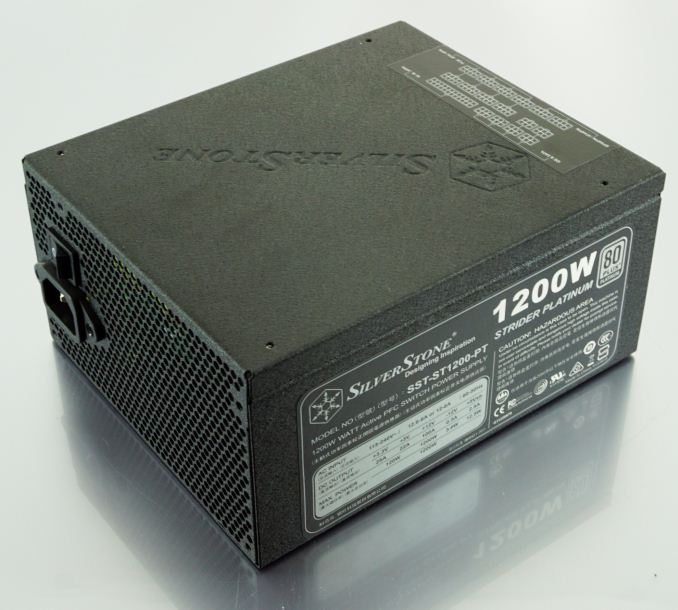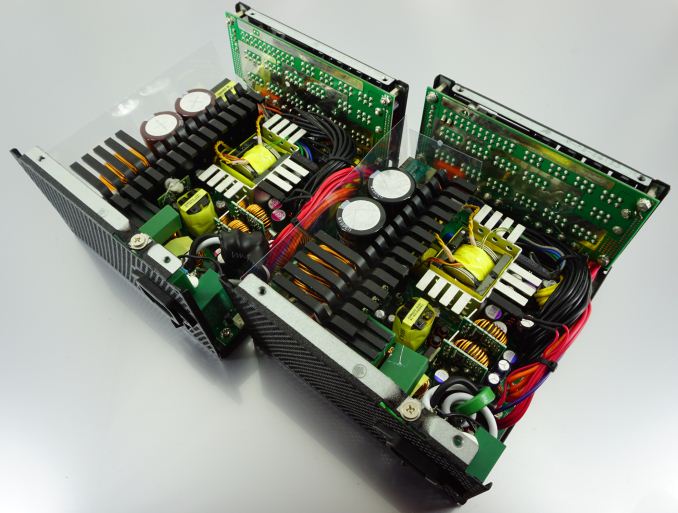The SilverStone Strider Platinum ST1000-PT & ST1200-PT PSU Review: Tenured
by E. Fylladitakis on May 4, 2018 9:00 AM EST- Posted in
- Cases/Cooling/PSUs
- PSUs
- SilverStone
- 80Plus Platinum
Conclusion
Summing up our thoughts, let's start with a look at what separates the Strider Platinum ST1000-PT and ST1200-PT from each other; or rather in this case, the lack of separation. Due to their practically identical target markets – high-end gamers and professionals who intent on using more than two GPUs – the two PSUs are all but indistinguishable, both physically and in terms of performance. The only practical difference between the two units is that the ST1000-PT has six PCIe connectors, whereas the ST1200-PT sports eight, allowing the connection of an additional graphics card. Other than that, the appearance, quality, and even performance of the two PSUs is practically identical. The ST1200-PT displayed a tiny performance advantage in our review but this advantage was very small and, considering that the ST1000-PT was struggling to reach the 80Plus Platinum certification limits, it could have been just a manufacturing tolerance error between the two units.
The Strider Platinum 1000W and 1200W PSUs are very well made, with exceptional quality components. On the outside, SilverStone kept their aesthetics simple and elegant, with the engraved company logo at the top of the PSUs and the unique textured paint. Both units feature a full set of modular flat black cables, including the ATX 24-pin cable, that are preferred over sleeved cables when aesthetics are important. Inside the units we found SilverStone's "penetrator" cooling fans and a proven Enhance platform. Enhance did an excellent job keeping the design clean, the components of high quality, and the assembly job seamless.
Enhance's approach to high-end PSUs is different than that of most manufacturers. They focus almost the entirety of their energy on making the PSU reliable and relatively simple. We first saw the platform used in the ST1000-PT and the ST1200-PT almost a decade ago, meaning that as it's now an older design, Enhance has opted to boost the efficiency of the design primarily by using higher quality active components and relatively small additions/upgrades rather than trying new techniques. This is not necessarily a bad thing, as the manufacturer has accumulated a lot of experience on this particular platform, ensuring better quality control and proven long-term reliability.
On the other hand, by sticking to "what works", Enhance is not really trying to compete with the other OEMs in terms of performance. Everything regarding the performance of Strider Platinum units is acceptable but, on the other hand, the two high-end units do not actually excel anywhere. Both units barely reach their efficiency ratings and the electrical power quality is satisfactory but unexceptional, especially considering their class. The thermal performance is very good but the cooling profile is unbalanced, forcing the fans to overtask even when the temperature of the units is low. The fans do stop when the system is idling but will instantly reach audible levels with just a mediocre load.
The two most powerful SilverStone Strider Platinum units undoubtedly are very well made and reliable, as well as relatively compact for their power output, but their competitiveness in today's market is mediocre. Overall, the performance of both the ST1000-PT and the ST1200-PT is good, yet unimpressive, reducing the competitiveness of the two units against other products that are similarly priced and offer significantly better electrical and/or thermal performance. As only gamers and professionals who use three or more GPUs are virtually the only market of >=1kW units, it is a relatively small (and demanding) percentage of the market, in which the Strider Platinum does not display any other distinct advantage over the competition other than its proven quality. The high stability of the SilverStone Strider Platinum units under maximum load makes them very good for applications where the units will be heavily loaded 24/7, which may make them appealing to cryptominers during sale seasons and when offers are active.












21 Comments
View All Comments
techguymaxc - Friday, May 4, 2018 - link
I have a PC Power & Cooling 1200W Silencer Mark III that I purchased 5 years ago. It had already been on the market for a year or 2 at that point. It is also 180mm deep. I don't find the following statement to be terribly compelling, or remarkable, in light of this fact: "Both units are 180 mm deep, which is relatively short for units with that kind of power output, yet certainly longer than what the ATX standard dictates."milkywayer - Friday, May 4, 2018 - link
We need more compact SFX PSUs. I understand there is a market for this but it baffles me why I kept using tower cases after having moved to an SFF case which can fit a 1080 ti, 32 gigs of ram, 8700k, two 3.5inch hdd and multiple ssds. All in a case a about 30 the size of my previous case.CheapSushi - Friday, May 4, 2018 - link
I just really want an SFX-L PSU with two EPS connectors for HEDT boards. I really don't care for the size of regular PSU's anymore regardless of what I'm building and what case. It just seems natural that with everything else miniaturizing, getting better, etc, that PSU's should too. Hell, sometimes the PSU's are half the volume of the rest of what takes up the space in an build.close - Monday, May 7, 2018 - link
PSUs are the only component in a PC that have to use some pretty large components like thumb-sized electrolytic capacitors, transformers, chokes, or even the AC socket (by function and design) while also dissipating up to 100+W.Now of course problem might be solved by throwing enough money at it. But would you still like the sticker price?
DanNeely - Monday, May 7, 2018 - link
There're SFX sized PSUs powerful enough to run dual GPUs, so there's no technical reason they couldn't offer 2xEPS connectors instead.I'd suggest @CheapSushi look for a modular design that uses the same 12V connector on the PSU for the EPS and GPU cables; then get 2nd EPS cable for it separately. With full ATX if they use the same PSUside plug or not is hit and miss, so you need to look closely. It should be clear from the markings on the PSU itself though if they're specialized or generic 12V 8 pin sockets.
close - Tuesday, May 8, 2018 - link
Sorry, I somehow read the comment as "I really don't care for the size of [SFX] PSUs anymore". Was wondering how much smaller can they get ant still do the job at a reasonable price.DanNeely - Tuesday, May 8, 2018 - link
There isn't a standard size significantly smaller than SFX. The longer narrower TFX spec might be a better fit for really thin SFF cases, but is only a few percent smaller in internal volume. Below that in size you end up with PicoPSU's and their equivalent which take a 12V (or 19V in some higher power models) external power brick which plugs into a tiny PCB that plugs into the 24pin atx connector and has a handful of other cables branch off from there. Looking at the size of higher powered laptop bricks you probably could make a 1/2 to 1/4 SFX sized internal PSU with a 40/50mm fan for GPUless SFF systems; but with even smaller platforms like NUC eating that segment of the market there probably isn't the demand for it.DanNeely - Tuesday, May 8, 2018 - link
There isn't a standard size significantly smaller than SFX. The longer narrower TFX spec might be a better fit for really thin SFF cases, but is only a few percent smaller in internal volume. Below that in size you end up with PicoPSU's and their equivalent which take a 12V (or 19V in some higher power models) external power brick which plugs into a tiny PCB that plugs into the 24pin atx connector and has a handful of other cables branch off from there. Looking at the size of higher powered laptop bricks you probably could make a 1/2 to 1/4 SFX sized internal PSU with a 40/50mm fan for GPUless SFF systems; but with even smaller platforms like NUC eating that segment of the market there probably isn't the demand for it.CheapSushi - Wednesday, May 9, 2018 - link
Also look into PSU's like FSP's Twins 500W. Two PSU's, redundant, in the same ATX form factor and then tell me power density can't be improved in SFX and SFX-L.CheapSushi - Wednesday, May 9, 2018 - link
One issue is that PSU cables are not standardized. I've seen some SFX PSU's label their port as GPU & CPU. But some other SFX PSU's don't. I've read some people have accidentally screwed up their mobos because of this.As for close, there are SFX-L examples already showing what you can do with density. There's already new improvements taking hold with all digital designs and for example Corsair using Gallium Nitride (GaN) MOSFET's. I am 100% prepared to pay more for better SFX and SFX-L PSU's and as they become the norm and companies focus more on them, price would go down regardless. You're assuming just because parts are larger than power per volume can't get any better. That's not true at all. I just don't see the point of ATX anymore in terms of necessity unless going up to 1500W to 2000W where you do need more space. Almost every single consumer rig, gaming rig and most workstations have enough with SFX and SFX-L. Just my issue is that power cables are NOT standardized, the ports aren't standardized and I can't seem to find an SFX-L with 100% assured confidence that I can use a port for a second EPS.